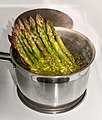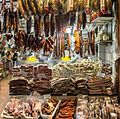F o o d
A portal dedicated to food and foodways
Introduction
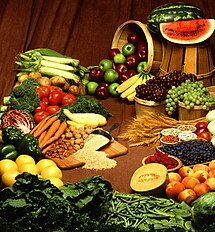
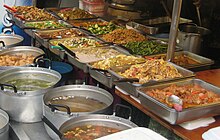
Food is any substance consumed by an organism for nutritional support. Food is usually of plant, animal, or fungal origin and contains essential nutrients such as carbohydrates, fats, proteins, vitamins, or minerals. The substance is ingested by an organism and assimilated by the organism's cells to provide energy, maintain life, or stimulate growth. Different species of animals have different feeding behaviours that satisfy the needs of their metabolisms and have evolved to fill a specific ecological niche within specific geographical contexts.
Omnivorous humans are highly adaptable and have adapted to obtain food in many different ecosystems. Humans generally use cooking to prepare food for consumption. The majority of the food energy required is supplied by the industrial food industry, which produces food through intensive agriculture and distributes it through complex food processing and food distribution systems. This system of conventional agriculture relies heavily on fossil fuels, which means that the food and agricultural systems are one of the major contributors to climate change, accounting for as much as 37% of total greenhouse gas emissions. (Full article...)
Cooking, also known as cookery or professionally as the culinary arts, is the art, science and craft of using heat to make food more palatable, digestible, nutritious, or safe. Cooking techniques and ingredients vary widely, from grilling food over an open fire, to using electric stoves, to baking in various types of ovens, reflecting local conditions. Cooking is an aspect of all human societies and a cultural universal.
Preparing food with heat or fire is an activity unique to humans. Archeological evidence of cooking fires from at least 300,000 years ago exists, but some estimate that humans started cooking up to 2 million years ago.
The expansion of agriculture, commerce, trade, and transportation between civilizations in different regions offered cooks many new ingredients. New inventions and technologies, such as the invention of pottery for holding and boiling of water, expanded cooking techniques. Some modern cooks apply advanced scientific techniques to food preparation to further enhance the flavor of the dish served. (Full article...)
The Art of Cookery Made Plain and Easy is a cookbook by Hannah Glasse (1708–1770), first published in 1747. It was a bestseller for a century after its first publication, dominating the English-speaking market and making Glasse one of the most famous cookbook authors of her time. The book ran through at least 40 editions, many of which were copied without explicit author consent. It was published in Dublin from 1748, and in America from 1805.
Glasse said in her note "To the Reader" that she used plain language so that servants would be able to understand it. (Full article...) (Full article...)
Selected article –
Tempeh or tempe (/ˈtɛmpeɪ/; Javanese: ꦠꦺꦩ꧀ꦥꦺ, romanized: témpé, Javanese pronunciation: [tempe]) is a traditional Indonesian food made from fermented soybeans. It is made by a natural culturing and controlled fermentation process that binds soybeans into a cake form. A fungus, Rhizopus oligosporus or Rhizopus oryzae, is used in the fermentation process and is also known as tempeh starter.
It is especially popular on the island of Java, where it is a staple source of protein. Like tofu, tempeh is made from soybeans, but it is a whole-soybean product with different nutritional characteristics and textural qualities. Tempeh's fermentation process and its retention of the whole bean give it a higher content of protein, dietary fiber, and vitamins. It has a firm texture and an earthy flavor, which becomes more pronounced as it ages. (Full article...)
Selected cuisine -
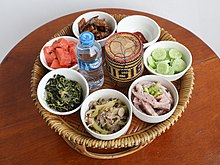
Lao cuisine or Laotian cuisine (Lao: ອາຫານລາວ, pronounced [ʔàː.hǎːn láːw], RTGS: ahan lao) is the national cuisine of Laos.
The staple food of the Lao is sticky rice (Lao: ເຂົ້າໜຽວ, khao niao, [kʰȁw nǐaw]). Laos has the highest sticky rice consumption per-capita in the world with an average of 171 kilograms (377 lb) of sticky rice consumed annually per person. Sticky rice is deeply ingrained in the culture, religious tradition, and national identity of Laos. It is a common belief within the Lao community that no matter where they are in the world, sticky rice will always be the glue that holds the Lao communities together, connecting them to their culture and to Laos. Affinity for sticky rice is considered the essence of what it means to be Lao. Often the Lao will refer to themselves as luk khao niao (Lao: ລູກເຂົ້າໜຽວ, [lùːk kʰȁw nǐaw]), which can be translated as 'children or descendants of sticky rice'. (Full article...)
Selected ingredient –
Breadcrumbs, also known as breading, consist of crumbled bread of various dryness, sometimes with seasonings added, used for breading or crumbing foods, topping casseroles, stuffing poultry, thickening stews, adding inexpensive bulk to soups, meatloaves and similar foods, and making a crisp and crunchy covering for fried foods, especially breaded cutlets like tonkatsu and schnitzel. The Japanese variety of breadcrumbs is called "panko". (Full article...)
Selected recipe –
Vindaloo or Vindalho is an Indian curry dish, originally from Vasai and Goa.
It is based on the Portuguese dish carne de vinha d'alhos. It is known globally in its British Indian form as a staple of curry house and Indian restaurant menus and is often regarded as a fiery, spicy dish. The traditional recipe uses pork, but alternative versions have been prepared with beef, mutton, prawns, chicken, lamb, vegetables and tofu. (Full article...)
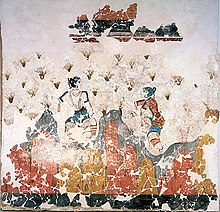
Human cultivation and use of saffron spans more than 3,500 years and extends across cultures, continents, and civilizations. Saffron, a spice derived from the dried stigmas of the saffron crocus (Crocus sativus), has through history remained among the world's most costly substances. With its bitter taste, hay-like fragrance, and slight metallic notes, the apocarotenoid-rich saffron has been used as a seasoning, fragrance, dye, and medicine.
The wild precursor of domesticated saffron crocus was likely Crocus cartwrightianus, a plant native to mainland Greece, Euboea, Crete, Skyros and some islands of the Cyclades. This species has been used as a wild source of saffron. A study reported in 2019 that the authors considered that a cross between two cytotypes of Crocus cartwrightianus was responsible for the emergence of Crocus sativus. This was probably a unique or very rare event as there is no genetic diversity in commercial saffron today. Another study in 2019 showed that a population of Crocus cartwrightianus near Athens in Attica was the closest match to the theoretical ancestors of Crocus sativus. (Full article...)
Selected image –

Selected biography –
B. April 24, 1914 – d. September 5, 2001
"Way back when I first started as a safety engineer, I took myself pretty seriously, and I found I was putting my audiences to sleep. So having lived all my life among the Cajuns of Louisiana, and having a good memory for the patois and the type of humor Cajuns go for, I started interspersing my talks on safety with Cajun humor."
Justin Wilson
Justin Elmer Wilson (April 24, 1914 – September 5, 2001) was a Southern American chef and humorist known for his brand of Cajun-inspired cuisine, humor and storytelling. (Full article...)
Did you know (auto-generated) –

- ... that an investigation found that most Mexican nutrition science students could not interpret a nutritional front-of-package labeling system correctly?
- ... that the bondiola sandwich is a popular street food in Argentina?
- ... that the Tapuae-o-Uenuku / Hector Mountains have been an important mahinga kai (food-gathering site) for the Māori for more than 600 years?
- ... that the café C1 Espresso delivers food to customers using pneumatic tubes?
- ... that the reactions to food depicted in the manga series Food Wars!: Shokugeki no Soma were decided on through free association games?
- ... that a New York pop-up restaurant opened by Louisa Shafia served stews and rice dishes described in a review as a "Persian-tapas gateway into the ancient cuisine"?
More did you know –
Related portals
Food topics
The following are topics relating to food
Categories
Food list articles
- See also: Lists of foods and Category:Lists of drinks
The following are some Food list articles on Wikipedia:

- American cheeses
- Appellation d'Origine Contrôlée cheeses
- Apple cultivars
- Bacon dishes
- Bacon substitutes
- Basil cultivars
- Breads
- Breakfast beverages
- Breakfast cereals
- Breakfast foods
- British cheeses
- Cakes
- Candies
- Cheeses
- Cheese soups
- Christmas dishes (list)
- Cocktails
- Cookies
- Dishes using coconut milk
- Diets
- Doughnut varieties
- Egg dishes
- Fermented soy products
- Food additives
- Food additives (Codex Alimentarius)
- Foods named after people
- French cheeses
- French dishes
- Fried dough foods
- Fruits
- List of hamburgers
- Herbs and spices
- Hors d'oeuvre
- Indian dishes
- Indian snack foods
- Indonesian dishes
- Italian dishes
- Japanese snacks
- Japanese dishes
- Jewish dishes
- Kebabs
- Korean beverages
- Mango cultivars
- Moroccan dishes
- Pasta
- Pastries
- Philippine snack food
- Pies, tarts and flans
- Poppy seed pastries and dishes
- Potato dishes
- Puddings
- Raw fish dishes
- Rice dishes
- Rolled foods
- Sauces
- Seafood
- Seeds
- Sandwiches
- Snack foods
- Soft drinks by country
- Soul foods and dishes
- Soups
- Stews
- Street foods
- Tapas
- Turkish dishes
- Twice-baked foods
- Vegetable oils
- Vegetables
- Vodkas
Things you can do
Related WikiProjects
| Parent project: WikiProject Food and Drink | |
| Child projects: | Task forces: (All inactive) |
|
|
| Related projects: | |
New articles
Rules | Match log | Results page (for watching) | Last updated: 2024-10-02 19:17 (UTC)
Note: The list display can now be customized by each user. See List display personalization for details.
- URL Coffee (edit | talk | history | links | watch | logs | tools) by Another Believer (talk · contribs · new pages (75)) started on 2024-10-01, score: 10
- Leon Coffee House (edit | talk | history | links | watch | logs | tools) by Another Believer (talk · contribs · new pages (75)) started on 2024-10-01, score: 10
- Mountain Dew VooDew (edit | talk | history | links | watch | logs | tools) by MC-123 (talk · contribs · new pages (15)) started on 2024-10-01, score: 20
- 2024 Pacific League Climax Series (edit | talk | history | links | watch | logs | tools) by Torsodog (talk · contribs · new pages (5)) started on 2024-10-01, score: 10
- California Garlic Festival (edit | talk | history | links | watch | logs | tools) by Paisa (talk · contribs · new pages (1)) started on 2024-09-30, score: 20
- The Shipwright's Daughter (edit | talk | history | links | watch | logs | tools) by Another Believer (talk · contribs · new pages (75)) started on 2024-09-26, score: 10
- Cicada ice cream (edit | talk | history | links | watch | logs | tools) by NicoleRoberts1117 (talk · contribs · new pages (2)) started on 2024-09-23, score: 10
- Thipsamai (edit | talk | history | links | watch | logs | tools) by Crcolas (talk · contribs · new pages (18)) started on 2024-09-30, score: 10
- The Chocolate Box (company) (edit | talk | history | links | watch | logs | tools) by Arthur Taksin (talk · contribs · new pages (2)) started on 2024-09-30, score: 30
- Organic Cocoa Production and Export Cooperative (edit | talk | history | links | watch | logs | tools) by Yue (talk · contribs · new pages (9)) started on 2024-09-30, score: 20
- Atching Lillian (edit | talk | history | links | watch | logs | tools) by Bagoto (talk · contribs · new pages (11)) started on 2024-09-30, score: 10
- Baleron (edit | talk | history | links | watch | logs | tools) by Altenmann (talk · contribs · new pages (72)) started on 2024-09-30, score: 10
- As a Thief in the Night (edit | talk | history | links | watch | logs | tools) by Lord Cornwallis (talk · contribs · new pages (138)) started on 2024-09-29, score: 10
- Aspire (Energy) (edit | talk | history | links | watch | logs | tools) by TheJodeciadams (talk · contribs · new pages (1)) started on 2024-09-22, score: 10
- Chocolate Room (edit | talk | history | links | watch | logs | tools) by Rollinginhisgrave (talk · contribs · new pages (5)) started on 2024-09-29, score: 10
- Mr. Pottermack's Oversight (edit | talk | history | links | watch | logs | tools) by Lord Cornwallis (talk · contribs · new pages (138)) started on 2024-09-28, score: 10
- Torchy's Tacos (edit | talk | history | links | watch | logs | tools) by PootisHeavy (talk · contribs · new pages (18)) started on 2024-09-28, score: 20
- Propionate fermentation (edit | talk | history | links | watch | logs | tools) by Johnbishop474 (talk · contribs · new pages (1)) started on 2024-09-27, score: 10
- North of Bourbon (edit | talk | history | links | watch | logs | tools) by Another Believer (talk · contribs · new pages (75)) started on 2024-09-26, score: 10
- Javonte Cooke (edit | talk | history | links | watch | logs | tools) by Sportsagentsam (talk · contribs · new pages (6)) started on 2024-09-26, score: 10
- Teaberry ice cream (edit | talk | history | links | watch | logs | tools) by Jake Choke (talk · contribs · new pages (3)) started on 2024-09-27, score: 10
- Camélia (restaurant) (edit | talk | history | links | watch | logs | tools) by Another Believer (talk · contribs · new pages (75)) started on 2024-09-26, score: 10
- Fikscue (edit | talk | history | links | watch | logs | tools) by Another Believer (talk · contribs · new pages (75)) started on 2024-09-26, score: 10
- Jack Fagan (journalist) (edit | talk | history | links | watch | logs | tools) by CorkMan (talk · contribs · new pages (14)) started on 2024-09-26, score: 10
- Bluestone Lane (edit | talk | history | links | watch | logs | tools) by Another Believer (talk · contribs · new pages (75)) started on 2024-09-26, score: 10
- Chef Geoff's (edit | talk | history | links | watch | logs | tools) by Another Believer (talk · contribs · new pages (75)) started on 2024-09-26, score: 10
- MartinBauer (edit | talk | history | links | watch | logs | tools) by Pfefferminze1930 (talk · contribs · new pages (1)) started on 2024-09-26, score: 20
- Black raspberry ice cream (edit | talk | history | links | watch | logs | tools) by Jake Choke (talk · contribs · new pages (3)) started on 2024-09-25, score: 30
- Bhagyalaxmi Dairy Farms (edit | talk | history | links | watch | logs | tools) by Whatif222 (talk · contribs · new pages (12)) started on 2024-09-25, score: 20
- Joe Yonan (edit | talk | history | links | watch | logs | tools) by Classicfilms (talk · contribs · new pages (1)) started on 2024-09-25, score: 10
- Gran Caffè Schenardi (edit | talk | history | links | watch | logs | tools) by Rococo1700 (talk · contribs · new pages (33)) started on 2024-09-25, score: 10
- Penny (restaurant) (edit | talk | history | links | watch | logs | tools) by MainlyTwelve (talk · contribs · new pages (5)) started on 2024-09-24, score: 20
- 40/40 Club (venue) (edit | talk | history | links | watch | logs | tools) by Lovewhatyoudo (talk · contribs · new pages (3)) started on 2024-09-24, score: 10
- Galaxy Gas (edit | talk | history | links | watch | logs | tools) by B3251 (talk · contribs · new pages (11)) started on 2024-09-24, score: 20
- BC Tree Fruits Cooperative (edit | talk | history | links | watch | logs | tools) by Lukebayy (talk · contribs · new pages (1)) started on 2024-09-23, score: 30
- Orange Crush (cocktail) (edit | talk | history | links | watch | logs | tools) by Pemilligan (talk · contribs · new pages (4)) started on 2024-09-23, score: 20
- Csigatészta (edit | talk | history | links | watch | logs | tools) by Konnor Martin (talk · contribs · new pages (1)) started on 2024-09-23, score: 20
- Rechao (edit | talk | history | links | watch | logs | tools) by Cunard (talk · contribs · new pages (2)) started on 2024-09-23, score: 10
- Lunchly (edit | talk | history | links | watch | logs | tools) by That Northern Irish Historian (talk · contribs · new pages (3)) started on 2024-09-22, score: 10
- Reed Hearon (edit | talk | history | links | watch | logs | tools) by PigeonChickenFish (talk · contribs · new pages (76)) started on 2024-09-22, score: 10
- The Pine (edit | talk | history | links | watch | logs | tools) by Another Believer (talk · contribs · new pages (75)) started on 2024-09-19, score: 10
- Hexagon (restaurant) (edit | talk | history | links | watch | logs | tools) by Another Believer (talk · contribs · new pages (75)) started on 2024-09-19, score: 10
- DaNico (edit | talk | history | links | watch | logs | tools) by Another Believer (talk · contribs · new pages (75)) started on 2024-09-19, score: 10
- Carcamusas (edit | talk | history | links | watch | logs | tools) by Asqueladd (talk · contribs · new pages (40)) started on 2024-09-21, score: 10
- Mee tauhu (edit | talk | history | links | watch | logs | tools) by The Bangsawan (talk · contribs · new pages (4)) started on 2024-09-21, score: 10
- Carla Martin (anthropologist) (edit | talk | history | links | watch | logs | tools) by Rollinginhisgrave (talk · contribs · new pages (5)) started on 2024-09-14, score: 10
- Abracadaver (Lovesey novel) (edit | talk | history | links | watch | logs | tools) by Lord Cornwallis (talk · contribs · new pages (138)) started on 2024-09-20, score: 10
- Kleinaspergle (edit | talk | history | links | watch | logs | tools) by Tenpop421 (talk · contribs · new pages (31)) started on 2024-09-19, score: 10
- Sarbhaja (edit | talk | history | links | watch | logs | tools) by খাঁ শুভেন্দু (talk · contribs · new pages (4)) started on 2024-09-19, score: 20
- Tilkor Tarua (edit | talk | history | links | watch | logs | tools) by Sntshkumar750 (talk · contribs · new pages (13)) started on 2024-09-19, score: 10
- Japfa (edit | talk | history | links | watch | logs | tools) by Juxlos (talk · contribs · new pages (4)) started on 2024-09-19, score: 20
- Coffee ice cream (edit | talk | history | links | watch | logs | tools) by Jake Choke (talk · contribs · new pages (3)) started on 2024-09-19, score: 40
- Crazee Burger (edit | talk | history | links | watch | logs | tools) by DarkNight0917 (talk · contribs · new pages (7)) started on 2024-09-19, score: 10
- Paturi (Bengali dish) (edit | talk | history | links | watch | logs | tools) by খাঁ শুভেন্দু (talk · contribs · new pages (4)) started on 2024-09-13, score: 20
- Macaroni Riots (edit | talk | history | links | watch | logs | tools) by JJonahJackalope (talk · contribs · new pages (2)) started on 2024-09-18, score: 10
- Suthon Sukphisit (edit | talk | history | links | watch | logs | tools) by Crcolas (talk · contribs · new pages (18)) started on 2024-09-18, score: 10
- BestMaid (edit | talk | history | links | watch | logs | tools) by Thief-River-Faller (talk · contribs · new pages (48)) started on 2024-09-18, score: 10
Associated Wikimedia
The following Wikimedia Foundation sister projects provide more on this subject:
-
Commons
Free media repository -
Wikibooks
Free textbooks and manuals -
Wikidata
Free knowledge base -
Wikinews
Free-content news -
Wikiquote
Collection of quotations -
Wikisource
Free-content library -
Wikiversity
Free learning tools -
Wiktionary
Dictionary and thesaurus
